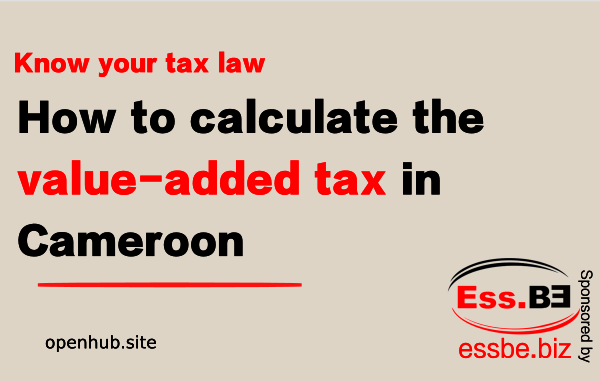How to calculate value-added tax in Cameroon
VAT is an indirect tax that is levied on consumption in Cameroon. It is not paid directly by the consumer who bears the tax burden but by those who are by law allowed to collect it on behalf of the tax authorities.
Nobody loves value-added tax, but we are obliged to pay. In spite of the fact that we pay as consumers, most of us don’t even know how it is calculated. But then when you work as an accountant, you need to know how to handle VAT especially if where you work is VAT-liable. You will need to know if the figures are VAT inclusive or exclusive.
Read Also: True or False? Cameroon Offers a 2-Year Tax Exemption for New Businesses
The VAT rate in Cameroon
[rml_read_more]
The standard rate of VAT in Cameroon is 19.25% broken down into
Real rate: 17.5% and
Additional council tax of 10% of the principal which gives you 1.75%. The total which gives you 19.25.
There are two main methods to calculate VAT.
- Calculating VAT using the net figure and
- Extracting VAT using the gross figure
As I explained above, VAT figures are either inclusive or exclusive. Inclusive means the VAT figure is within the gross figure and exclusive means the it is still net without VAT.
To understand better, let’s consider the net as the amount before VAT is included and the gross as the amount including VAT. We use this when calculating sales invoices that takes into consideration the VAT. For instance if you are making a sale
- The net value is the amount that belongs to your business and
- The VAT amount is that collected by your business on behalf of the government treasury and
- The gross amount is what the customer will pay
Calculating VAT using the net figure and
Let’s make a virtual invoice ans see how it works. Let’s consider the description as Net (VAT exclusive), VAT and gross (VAT inclusive)
Above is part of our invoice. Let’s consider that the net price of our sales is 100,000frs and our VAT is 19.25%.
We want to add VAT to the net amount to get the gross. The formula to be used is 1+VAT percentage X the net amount will give you the gross amount.
In the case above:
1+0.1925 = 1.1925
Gross amount = 1.1925 X 100,000f = 119,250f
Extracting VAT using the gross figure
Now let’s exclude VAT from the gross amount. This happens when a business has received an invoice and needs to get what is due them and remove what they have collected on behalf of the government treasury.
This is how it goes:
Divide the gross amount by 1 + VAT percentage, subtract the gross amount and multiply by -1. Two things happen here:
- You got the exact amount of VAT to be put in the government treasury which you have to bring down to the nearest thousand as provided by the law and
- You get the net amount which is that for the company
Let’s calculate the above:
Gross = 119,250f
VAT = ?
Net = ?
Therefore 1 + 0.1925 = 1.1925 divided by 119,250f
Net = 1.1925 / 119,250f = 100,000f
100,000 – 119,250 = -19,250
Multiply by -1
VAT = -1 X -19,250 = 19,250
NB: The value gotten is brought down to the nearest thousand.
VAT Payable or Output VAT
VAT payable is what you collect from clients to pay to the government treasury. This is found on invoices you are sending to customers. That is, VAT payable is found on invoices that you are sending from your company to other companies. Companies that are VAT-liable send their invoices to their customers applying VAT of which the customer pays the gross amount (except the case where the customer is exempted from paying VAT).
The output VAT is then paid to the tax authorities after deducting the input VAT. This is done on or before the 15th of the month following that which it was collected in the case of Cameroon.
VAT Receivable or Input VAT
The input VAT is found on invoices that come into your company. This means input VAT comes in from supplier invoices when ever you make a purchase from a VAT-liable company. The value-added tax receivable is usually deductible. In this case, if your company makes more purchases than sales, they will get a surplus, reason why it is called VAT receivable.
- Job Opportunities at Special Gems School, Bonamoussadi, Douala
- Job Opportunities at KidzHub English Nursery and Primary School
- Job Opportunity: Skin Care Salesperson
- What the Oryx Taught Me About Business Survival
- Sekakoh Empowers Rural Communities with Agricultural Training and Quality Seeds
If the VAT payable is more than VAT receivable, then the surplus is your business’ tax liability to the tax authorities. The balance will have to be paid to the tax authorities. In effect, businesses that sell more than they purchase usually have a surplus output VAT.
On the other hand, businesses that purchase more than they sell usually get a surplus VAT. The reason it is called VAT receivable.
Sources: Tax Department | Ministry of Finance
Discover more from OpenHub Digital
Subscribe to get the latest posts sent to your email.


